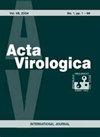Genetic diversity analysis of grapevine rupestris stem pitting-associated virus from grapevine by colony PCR-SSCP and -RFLP.
IF 0.8
4区 医学
Q4 VIROLOGY
引用次数: 1
Abstract
We have developed methods for detecting the genetic diversity of grapevine rupestris stem pitting-associated virus (GRSPaV) based on restriction fragment length polymorphism (RFLP) and single stranded conformational polymorphism (SSCP) in the 905 nt 3' sequence. The amplicons were cloned from six grapevine cultivars, and colony polymerase chain reaction (colony PCR) using recombination bacteria was subsequently analyzed by RFLP and SSCP. Four haplotypes of SSCP and six haplotypes of Sac I RFLPs were defined. The two methods had a 40% discrepancy rate in showing the degree of diversity. All clones were sequenced and were used to construct a phylogenetic tree with seven previously reported GRSPaV sequences. In the tree, all the newly acquired sequences were divided into three clusters, I, II, and III, which corresponded to haplotypes I, II, and III of SSCP, respectively. Haplotype IV of SSCP was grouped into cluster II. A recombination analysis showed that haplotype IV has undergone a recombination event. Together, these results indicate that the SSCP assay is useful for the rapid identification of genetic diversity of GRSPaV. This is the first report of an analysis of the large fragment of GRSPaV by colony PCR-SSCP. Keywords: grapevine; grapevine rupestris stem pitting-associated virus (GRSPaV); RFLP; SSCP; genetic diversity analysis.利用菌落PCR-SSCP和-RFLP分析葡萄葡萄茎蚀相关病毒的遗传多样性。
基于905nt 3′序列的限制性内切片段长度多态性(RFLP)和单链构象多态性(SSCP),建立了葡萄葡萄茎蚀相关病毒(GRSPaV)遗传多样性检测方法。从6个葡萄品种中克隆扩增子,利用重组菌进行集落聚合酶链反应(colony polymerase chain reaction, PCR),并采用RFLP和SSCP对扩增子进行分析。定义了SSCP的4个单倍型和Sac I RFLPs的6个单倍型。这两种方法在显示多样性程度方面的差异率为40%。对所有克隆进行测序,并利用先前报道的7个GRSPaV序列构建系统发育树。在树中,所有新获得的序列被划分为3个簇,分别对应于SSCP的I、II和III单倍型。SSCP的单倍型IV被归为聚类II。重组分析表明,单倍型IV发生了重组事件。综上所述,这些结果表明SSCP检测方法可用于快速鉴定GRSPaV的遗传多样性。这是第一个用群体PCR-SSCP分析GRSPaV大片段的报道。关键词:小道消息;葡萄葡萄梗点蚀相关病毒(GRSPaV);RFLP;SSCP;遗传多样性分析。
本文章由计算机程序翻译,如有差异,请以英文原文为准。
求助全文
约1分钟内获得全文
求助全文
来源期刊

Acta virologica
医学-病毒学
CiteScore
3.10
自引率
11.80%
发文量
43
审稿时长
>12 weeks
期刊介绍:
Acta virologica is an international journal of predominantly molecular and cellular virology. Acta virologica aims to publish papers reporting original results of fundamental and applied research mainly on human, animal and plant viruses at cellular and molecular level. As a matter of tradition, also rickettsiae are included. Areas of interest are virus structure and morphology, molecular biology of virus-cell interactions, molecular genetics of viruses, pathogenesis of viral diseases, viral immunology, vaccines, antiviral drugs and viral diagnostics.
 求助内容:
求助内容: 应助结果提醒方式:
应助结果提醒方式:


